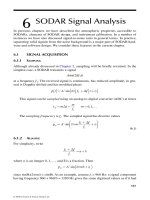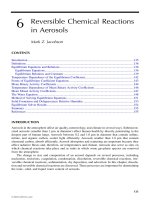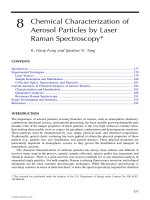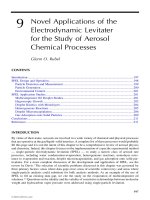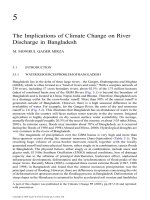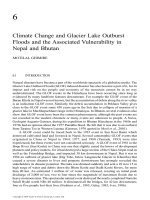LANDSCAPE ECOLOGY in AGROECOSYSTEMS MANAGEMENT - CHAPTER 6 pdf
Bạn đang xem bản rút gọn của tài liệu. Xem và tải ngay bản đầy đủ của tài liệu tại đây (509.45 KB, 13 trang )
CHAPTER
6
Implementation of Riparian Buffer
Systems for Landscape Management
Richard Lowrance and Susan R. Crow
CONTENTS
Buffers as Critical Components of Managed Landscapes
Riparian Ecosystem Functions in Agricultural Landscapes
Purposes of Riparian Ecosystem Buffers
Making Buffers Sustainable at Multiple Scales in Agricultural Landscapes
USDA Programs for Riparian Ecosystem Buffers
Simple Decision Tree for Riparian Ecosystem Decision Making
Summary
References
BUFFERS AS CRITICAL COMPONENTS
OF MANAGED LANDSCAPES
In recent years efforts have been made to incorporate a landscape perspective
into U.S. national policy initiatives for land management. Supporting these efforts,
landscape ecology has been regarded as an effective paradigm for organizing and
evaluating various approaches to land management. In part, this reflects landscape
ecology’s focus on applying principles derived from studying landscape elements,
their interactions and changes over time, to solving practical problems in the real
world. A fundamental premise of landscape ecology is that the pattern of component
ecosystems or landscape elements affects ecological processes. Study of landscape
pattern focuses on three basic landscape characteristics: structure, the spatial rela-
tionships among distinct ecosystems or landscape elements; function, the interactions
0919 ch06 frame Page 145 Tuesday, November 20, 2001 6:23 PM
© 2002 by CRC Press LLC
or flows of energy, materials, and species among ecosystems; and changes in land-
scape structure and function over time.
Within this context, landscape structure may be described as a mosaic of three
elements: patch, corridor, and matrix (Forman and Godron 1986). A patch is a unit
of a landscape represented by discrete areas or periods of relative homogeneity in
environmental conditions, and is perceived by organisms or relevant ecological
phenomenon of interest as bounded by discontinuity in environmental character.
Patches are dynamic, occurring at a variety of spatial and temporal scales. Thus, a
landscape is composed of a hierarchy of patch mosaics across a range of scales.
Corridors are narrow landscape elements differing from their surroundings, distin-
guished by their linear spatial configuration in which corridor width and sinuosity
are important characteristics. The landscape matrix is the most extensive and con-
nected of the elements composing a landscape and, therefore, is functionally the
most dominant landscape element. The overall pattern of landscape elements may
include networks in which patch number and configuration, corridor connectivity,
and boundary shapes affect flows and interactions of energy, matter, and species
which is particularly relevant to riparian landscapes.
It is important to note that landscape extent, as well as the area associated with
each landscape element, is dependent on the organism or ecological phenomenon
of interest. Therefore, there is no single definition of landscape. Rather, it is necessary
to define a landscape by delineating the land area of interacting landscape elements
relevant to a particular organism or phenomenon. There are at least two important
implications of defining landscape in this way. The first is that scale and context are
critical concerns for landscape description and management. For example, in char-
acterizing a particular landscape, is forest the landscape matrix or is forest an element
within an agricultural matrix? A second important implication relates to the degree
to which the landscape may be characterized as an open or closed system. If a
watershed is defined as the landscape of interest, from a hydrologic perspective at
least, the landscape may be considered a relatively closed system in which few
outputs leave the system. On the other hand, the system may be characterized as
relatively open in terms of species movement through the system. These implications
are particularly relevant to the management of landscapes containing typical agri-
cultural production systems because of the significant inputs and outputs associated
with these systems.
Landscapes and elements within landscapes may be more or less intensely
managed. In an agricultural landscape, for example, upland areas with fertile soils
are intensely manipulated, whereas lowlands with hydric soils and streams may not
be directly manipulated (though certainly they may receive significant inputs as a
result of management of adjacent areas). In these intensely
managed landscapes,
some landscape elements may be regarded as critical to mitigate exports of other
landscape components and thereby support the overall healthy functioning of the
landscape system. Landscape corridors are recognized as major structural and func-
tional components of the landscape, necessary to ecological regulatory processes
such as animal dispersal, habitat for nongame species, prevention of soil and wind
erosion, and integrated pest management (Barrett 1992). In addition, these landscape
elements may serve to mediate or buffer the effects of outputs from other landscape
0919 ch06 frame Page 146 Tuesday, November 20, 2001 6:23 PM
© 2002 by CRC Press LLC
components. In this context, riparian environments are critical components in land-
scapes managed for agricultural production, as well as other intensively managed
landscapes.
Riparian environments include those ecosystems adjacent to rivers and streams.
In addition to extensive floodplains, riparian zones include narrow strips along
downcutting rivers, islands, and channel landforms (Malanson 1993). These riparian
systems represent ecotones between terrestrial and aquatic ecosystems and are char-
acterized as landscape corridors in which lateral water flow is the main force
organizing and regulating the function of riparian wetlands and their role in the
landscape. These unique environments are of particular interest to land managers
and policy makers because of the indirect, but critically important, economic benefit
they serve in maintaining water quality. In particular, studies in agricultural land-
scapes have established the effectiveness of riparian vegetation in filtering agricul-
tural nutrients and trapping agricultural sediments. U.S. agricultural policy has
designated riparian buffer zones as eligible for inclusion in the U.S. Conservation
Reserve Program, allowing farmers to be paid not to farm these environmentally
sensitive lands if forest vegetation is regenerated either through planting or succession.
Agricultural production systems are inherently “leaky” for nutrients, sediment,
and agricultural chemicals. The degree of “leakiness” is generally measured by
comparing agricultural systems to nonagricultural systems, typically forested land-
scapes in humid regions. The leakiness is caused by numerous interacting factors,
including (1) tillage to produce seedbeds and control weeds; (2) application of
nutrients from fertilizer and manure; (3) application of xenobiotics to control pests;
(4) hydrologic modifications of drainage systems to remove excess water; and (5)
application of water to the root zone to relieve soil moisture deficits. Buffer zones,
established as landscape corridors in agricultural systems and existing as integral
landscape elements in agricultural watersheds and other landscapes, primarily have
been implemented to control the unplanned leaks from agricultural management
systems before they impact adjacent terrestrial, wetland, and aquatic ecosystems
(Lowrance et al. 1997). In addition, as discussed above, buffers are needed in agri-
cultural landscapes to serve other landscape functions such as wildlife habitat, visual
screens, and as setbacks from vulnerable ecosystems.
In addition to the more conventional view of buffers as primarily linear ecosys-
tems or ecotones juxtaposed between vulnerable ecosystems and an agricultural
production system, it is also useful to consider agriculture and buffer systems in a
more general way. Applying the concept of a buffer as any less intensively managed
portion of a landscape producing fewer external outputs than other landscape com-
ponents, agriculture may serve as a buffer. For instance, in urbanizing landscapes,
agriculture may serve as a transition between high density developments with a
significant percentage of impervious surfaces and nearby naturally functioning eco-
systems. This is the case for many areas at the edge of urban sprawl and is one of
the primary motivations for preserving agricultural lands for open space. The empha-
sis at the edge of urban areas should be on preserving agricultural land that can
contribute to food supply for the urban centers. Conversely, when agriculture is the
most intensive land use in a landscape, the nonagricultural landscape elements serve
as parts of the general buffer system supporting sustainability of the entire landscape.
0919 ch06 frame Page 147 Tuesday, November 20, 2001 6:23 PM
© 2002 by CRC Press LLC
This situation is especially true in ground water-dominated landscapes where most
lands are equally likely to provide recharge to ground water. In these sorts of systems,
water quality problems from agricultural production systems often may be avoided
by having a substantial part of the landscape in nonagricultural uses.
RIPARIAN ECOSYSTEM FUNCTIONS
IN AGRICULTURAL LANDSCAPES
Riparian ecosystems originally referred to streamside or riverside ecosystems
that developed due to the influence of the stream itself. The definition has now been
expanded to include almost any land adjacent to a freshwater system, including
ponds, lakes, ditches, and canals. As has been documented in numerous reports,
riparian ecosystems control many of the interactions among terrestrial and aquatic
ecosystems. Most receive subsidies in the form of water and nutrients from adjacent
uplands. Many are flooded periodically, but whether the flood acts as a subsidy or
not is a function of how often it is flooded and the severity of the flood. In areas of
infrequent scouring floods, the flood acts less as a subsidy and more as a perturbation
to produce new flow channels and to reset both soil and vegetation succession of
the systems. Although riparian systems are usually considered primarily as horizon-
tally connected to the stream and upslope ecosystems, there are also important
vertical connections with the hyporheic zone beneath the stream. This point is of
particular importance in regions where the hyporheic zone consists of gravel and
coarser materials and where there are large interstitial spaces for water and organisms.
Although typically referred to as ecosystems, riparian zones actually form eco-
tones between terrestrial and aquatic ecosystems. They may or may not be wetlands,
depending on both frequency and duration of flooding and hillslope hydrology.
Floodplain wetlands tend to develop in the riparian zone along larger streams and
rivers, while seepage wetlands tend to develop at the base of hillslopes along smaller
streams. As a result of their position in the landscape, riparian ecosystems often
serve as natural buffer zones. Most riparian ecosystems serving as buffers in agri-
cultural landscapes are functioning essentially as natural buffers with very little
management.
Most riparian buffers that have been studied, and that form the basis for our
knowledge of buffer system functions, are naturally occurring ecosystems that devel-
oped over time as forests were converted to agricultural landscapes (Jacobs and
Gilliam 1986, Lowrance et al. 1984, Peterjohn and Correll 1984). The water quality
functions of these naturally occurring buffers have been summarized in numerous
reviews and are represented from most to least general in Figure 6.1 (Lowrance et al.
1997). We have just recently begun to consider both the management and re-
establishment of riparian buffers where they are not functioning adequately or where
they do not exist (Schultz et al. 1995, Vellidis et al. 1993). The design of riparian
buffer systems for agricultural landscapes is in its infancy. Although it is theoretically
possible to design buffers that have a very high capacity to filter pollutants, it is not
clear that these buffers will maintain this function long term.
0919 ch06 frame Page 148 Tuesday, November 20, 2001 6:23 PM
© 2002 by CRC Press LLC
PURPOSES OF RIPARIAN ECOSYSTEM BUFFERS
Whether we realize it or not, we expect and receive numerous goods and services
from natural riparian ecosystems. We do not yet know which of these goods and
services may be sustained from restored or established riparian ecosystems. Natural
riparian ecosystems provide, at least, the following goods and services: retain sed-
iment; retain dust and windblown particles, including plant propagules; retain and
transform nutrients; retain and transform toxics; shade streams and margins of rivers
and lakes; provide leaf litter and woody debris as energy sources; provide woody
debris as substrate and channel structures; provide sources of biodiversity; increase
micro-topographic variability; provide carbon sinks; provide energy sinks, especially
for moving wind or water; provide sources of plant propagules; provide terrestrial
wildlife habitat; provide products such as wood and forage; and provide recreation,
hunting, and landscape aesthetics.
As fundamental components of agricultural landscapes, riparian buffers mitigate
off-site effects of production systems, including increased nutrient, sediment, and
pesticide loading. Agricultural landscapes, especially annual crops, decrease perma-
nent cover, wildlife habitat, and biodiversity, and they create undesirable habitats
for noncrop species. Buffers protect critical areas, including wetlands, recharge areas,
aquatic ecosystems, and endangered species habitat, and link landscape components,
providing corridors between critical areas and less disturbed areas. Buffers also may
decrease the intensity of agricultural production at the edges of critical areas. Ripar-
ian buffers provide specialized features for human use in managed landscapes,
including recreation, woodlots, and aesthetic experiences.
In a sense, riparian buffers serve as insurance to protect critical areas from both
unexpected and expected external effects of production systems. The expected effects
of production systems depend largely on the intensity of production and the extent
to which production systems dominate more natural systems. As noted above, if the
landscape matrix becomes agriculture, there are generally more expected effects
from the production system than if the matrix retains more of the character of natural
systems with agriculture located in the landscape on the most productive soils.
In countries practicing modern production agriculture, emphasizing water and
environmental quality best management practices, some have questioned why buffers
Figure 6.1
Most general to least general water quality functions.
Remove dissolved phosphorus
Remove nitrate from groundwater
Remove sediment & sediment bound chemicals
Control Aquatic Environment
0919 ch06 frame Page 149 Tuesday, November 20, 2001 6:23 PM
© 2002 by CRC Press LLC
would be needed for specific purposes such as nitrate removal. It is reasoned that
we now have the ability to keep chemicals applied where they belong in the landscape
to enhance crop production, and if we do that buffers are not needed to control these
chemicals. In short, we are capable of controlling crop production chemicals on site;
therefore, buffers are not required for their management. There is no doubt that
keeping chemicals where they belong, in the root zone or in plants, is the best way
to achieve water quality goals in agricultural landscapes. At doubt is our ability to
do this with the consistency needed to protect the environment.
At this point, what are expected effects and what are unexpected effects become
relevant questions. As long as we continue to till the soil, and use large amounts of
nutrients and xenobiotic chemicals, and cannot control the weather, conservative
management practice requires us to assume that the expected effects of agriculture
will be soil, nutrient, and chemical movement significantly beyond both the back-
ground from natural ecosystems and the ability of aquatic ecosystems to assimilate
and process. Given these conditions, implementing a combination of buffer systems
and proper field management will provide both the best regional environmental
quality and ecologically sustainable agriculture.
MAKING BUFFERS SUSTAINABLE AT MULTIPLE SCALES
IN AGRICULTURAL LANDSCAPES
The goal of establishing buffer systems integrated with conservation practices
in agricultural production areas is to ensure sustainable, productive landscapes.
Buffers mainly contribute to ecological sustainability (Lowrance et al. 1986) but
may also contribute to economic sustainability. Three biophysical factors influence
the ability of buffers to contribute to ecological sustainability: size, time, and man-
agement. The ecological sustainability of the buffer systems, and in turn the eco-
logical sustainability of the agricultural landscape, ultimately will be governed by
properties of the buffer systems interacting with properties of the production system.
Given the linear nature of riparian ecosystems, size involves both the linear extent
along a stream and the width of the buffer relative to specific pollutant sources. Size
matters in riparian ecosystems. Although it is clear that a continuous buffer is best,
it is not clear that there is an optimum buffer width, given the opportunity costs
associated with buffers relative to other more economically important land uses.
Simulation studies using the Riparian Ecosystem Management Model have shown
that most sediment and nutrient removal occurs in about 15m riparian buffer systems
in the U.S. Coastal Plain (Williams, et al. 2000). The generality of these results
needs to be tested in other regions. In the absence of government subsidy, optimum
buffer width, although lacking more specific definition, is the minimum width that
provides a desired control of pollutant externalities (both a societal and local benefit)
and provides other amenities desired by the landowner (primarily a local benefit).
Time required to establish buffer function also is variable, but it is likely to be
short in most areas. In areas of minor modification, such as a cut-over riparian forest,
many of the soil and hydrologic functions are still in place and vegetation will often
re-establish rapidly (Vellidis et al. 1993). In areas of major modification, such as
0919 ch06 frame Page 150 Wednesday, November 21, 2001 1:51 PM
© 2002 by CRC Press LLC
streamside fields, establishing a buffer will be a very large change in chemical
loading, tillage, etc., and establishment of buffer functions should be rapid relative
to the agricultural uses. Even in areas of surface drainage with ditches, providing
coarse woody debris to the stream in the first few years of buffer establishment
should have effects on flow regimes. The three agricultural scenarios most likely to
need longer time to re-establish buffer functions are areas with extensive subsurface
drainage, areas with intensive streamside use by domestic animals, and steep areas
with eroded soils.
Managing riparian buffers for multiple benefits is a new concept in modern
production agriculture. Although one approach to buffer design for pollution control
allows intensive management to be substituted for size, this may not be a realistic
approach in practice. Although many farmers may spend noncritical times (especially
winter) managing buffer areas for multiple benefits (especially as wood lots and
wildlife habitat), managing buffers for pollution control during the growing season
will not be a high priority for most farmers. Active growing-season buffer manage-
ment is probably not a realistic expectation for most modern farmers. Therefore,
buffers should be largely self-regulating, be highly resistant to failure during the
growing season, and be suitable for largely nongrowing season management.
To date, riparian buffers have been implemented largely on a field-by-field basis.
Future efforts should establish and evaluate riparian buffers at multiple spatial scales.
At the field scale, it is possible to adjust inputs and management to gain desired
outputs. Where there are likely to be greater outputs from a given field, for instance
an area in intensive vegetable or animal production, the farmer may implement a
larger riparian buffer to interact with in-field buffers such as contour filter strips or
grass waterways. At the farm-scale, the goal should be to integrate production
components where possible — rotations, animal manures, agroforestry — to buffer
critical areas on and adjacent to the farm. At the landscape scale, practices should
be coordinated to buffer and protect critical areas and link habitat resources with
buffer systems serving as landscape corridors. In most cases, it will be possible to
restore critical areas only through such coordinated efforts.
USDA PROGRAMS FOR RIPARIAN ECOSYSTEM BUFFERS
Riparian buffers are an important part of the USDA Conservation Buffer Initiative
(CBI), intended to have 2 million miles of total buffers installed by the year 2002.
Although the CBI includes many types of buffers, the focus of CBI financial incentive
programs has been to provide financial support for long-term riparian forest buffers
through the USDA Conservation Reserve Program (CRP) and the Conservation
Reserve Enhancement Programs carried out as state/USDA partnerships. Riparian
forest buffers are the primary practice implemented under the Continuous Sign-up
of the CRP (CS-CRP) which allows landowners to offer eligible acreage at any time.
Eligible acreage includes cropland along streams with a cropping history in 3 out
of the 5 most recent years or pastureland that is along streams (FSA 1997). As with
other CRP programs, the CS-CRP provides either 10- or 15-year annual rental
contracts between USDA and landowners. Unlike other CRP programs, CS-CRP for
0919 ch06 frame Page 151 Tuesday, November 20, 2001 6:23 PM
© 2002 by CRC Press LLC
riparian forest buffers provides a one-time sign-up bonus and increased cost-share
for installation of the practice. With the extra incentives, there is very little initial
cost to the landowner.
A comparison of the use of riparian forest buffers under CS-CRP in two states
provides insights into both the need for riparian forest buffers and the effectiveness
of USDA financial incentives for them. Iowa has extensive acreage of cropland along
streams and rental rates for CS-CRP land is from $150 to $175 per acre per year.
Georgia has much less row cropland along streams, more pastureland along streams,
and lower rental rates for riparian lands, typically $40 to $50 per acre per year. Rental
rates for both states are based on soil productivity for typical riparian soils. The
difference in rental rates is reflected in dramatic differences in both the overall use
of riparian forest buffers under CS-CRP and the distribution of new riparian forest
buffers under CS-CRP within the two states. From October, 1999 through April,
2001, over 22,500 acres of riparian forest buffer were installed under CS-CRP in
Iowa (USDA-NRCS-PRMS 2001). In contrast, only 1586 acres were installed under
CS-CRP in the same time period in Georgia (USDA-NRCS-PRMS 2001).
The distribution of CS-CRP riparian forest buffers in the two states is very
different also. In Iowa, CS-CRP riparian forest buffers are being installed in the
majority of counties. Although counties in the more humid eastern part of the state
have higher acreages, the practice is widespread under CS-CRP (Figure 6.2). In
Georgia, the practice is much less widespread geographically with the limited acre-
age concentrated in a few counties (Figure 6.2). Of the total CS-CRP riparian forest
buffer acreage in Georgia, 70% has been installed in five counties (out of 163 counties
total) with 38% in one county.
Although the CS-CRP recognizes the value of riparian buffers by providing for
continuous sign-up, the rental rates are tied to the agricultural productivity of the
land based on the soil type. This is a relatively successful approach in cases where
riparian soils are supporting productive croplands because the rental payment is
relatively high. However, where riparian soils are supporting pastures, and the soil
productivity is generally low, the program has not been as successful in re-estab-
lishing riparian buffers. Yet many streams in Georgia are impaired due to low
dissolved oxygen and high fecal coliform levels (SRWMD, 2000). Although cause
and effect are not well understood, both low dissolved oxygen and high fecal
coliform may be related to streamside pastures. These conditions indicate that some
important benefits to society are not being realized in CS-CRP riparian forest buffers
on pasturelands, and they suggest that adjusted rental rates might better capture the
overall societal values of riparian forest buffers. At this point, one of the most
pressing concerns for CS-CRP is to acquire more riparian pastureland for permanent
riparian forest buffers.
SIMPLE DECISION TREE FOR RIPARIAN ECOSYSTEM
DECISION MAKING
The functions of riparian ecosystems relate to their current conditions, as well
as to societal goals and landowner goals. A few simple decision trees will be used
0919 ch06 frame Page 152 Tuesday, November 20, 2001 6:23 PM
© 2002 by CRC Press LLC
here to illustrate possible interactions between riparian ecosystem conditions and
human goals to guide buffer design at a site or field scale.
If riparian systems are largely intact, the goal will be to use and enhance existing
riparian ecosystems (Figure 6.3). Unfortunately, incentives generally are not avail-
able to preserve existing riparian ecosystems. A few regulations exist, especially for
wetlands, but programs are needed to reward landowners for maintaining riparian
systems. In many cases, riparian systems could be enhanced for multiple purposes
via species enrichment, restocking, etc. However, very limited financial incentives
are available for these practices.
If current conditions include degraded riparian systems with minor hydrologic
modification, controlling nonpoint source pollution and restoring aquatic ecosystems
should be relatively straightforward (Figure 6.4). Controlling nonpoint source pol-
lution probably could be accomplished with any perennial vegetation; however,
restoring aquatic ecosystems will require native vegetation. Although USDA pro-
grams have a default minimum buffer width of 15 m, this minimum is not well
Figure 6.2
Comparison of Georgia and Iowa riparian forest buffer acres enrolled in the USDA
Conservation Reserve Program from October 1999 to April 2001.
0919 ch06 frame Page 153 Tuesday, November 20, 2001 6:23 PM
© 2002 by CRC Press LLC
tested. Practices implemented beyond the minimum distance for cost-share programs
such as CS-CRP will depend on landowner objectives.
Given the same existing situation described above — degraded riparian systems
and minor hydromodifications — restoring aquatic ecosystems and terrestrial wild-
life will require a wider buffer (Figure 6.5). The default minimum distance for
restoring aquatic ecosystems is only 5 m for USDA approved buffers, but, if terres-
trial habitat is a secondary goal, up to 100 m of perennial native vegetation is likely
Figure 6.3 Simple decision tree for riparian ecosystem selection — natural riparian ecosys-
tems in place.
Figure 6.4 Simple decision tree for riparian ecosystem selection — degraded riparian eco-
systems, minor hydromodification.
Figure 6.5
Simple decision tree for riparian ecosystem selection — degraded riparian eco-
systems, minor hydromodification.
Preserve through incentives
and/or regulations
Enhance through species
enrichment, restocking, etc.
Use Existing Riparian Ecosystems
Primary Goal: Control Nonpoint Source Pollution
Secondary Goal: Restore Aquatic Ecosystems
Determine minimum
distance
default=15 m
Determine Landowner
preference of vegetation
Restore native vegetation
for secondary objective
Establish productive system of perennial vegetation
Primary Goal: Control Nonpoint Source Pollution
Secondary Goal: Restore Aquatic Ecosystems
Determine minimum
distance
default=5 m
Determine Native
vegetation
Restore much wider buffer
for secondary goal
Establish native perennial vegetation
Primary Goal: Restore Aquatic Ecosystems
Secondary Goal: Terrestrial wildlife
0919 ch06 frame Page 154 Tuesday, November 20, 2001 6:23 PM
© 2002 by CRC Press LLC
needed. Alternatively, if restoring terrestrial wildlife habitat is the primary goal, it
is likely that all other objectives will be met as secondary goals (Figure 6.6).
The decision tree in Figure 6.7 reflects a hierarchy of buffer widths for achieving
different riparian ecosystems functions. Although not well tested, the hierarchy is
being implemented in USDA programs. Overall experience has shown that most
landowners establishing and maintaining riparian buffers in agricultural landscapes
are interested in buffers much wider than the minimum requirement. In general, the
first landowners participating in these programs are ones with broader stewardship
goals and desire to provide for terrestrial wildlife needs, as well as nonpoint source
pollution control and aquatic ecosystem restoration. When wildlife management
goals are met, it is almost certain that pollution and aquatic restoration goals also
will be met, if they can be met. In reality, the nonpoint source pollution goal,
especially relative to nitrate and dissolved phosphorus, probably is less certain to
be met and depends on hydrologic flow paths that are unknown for most systems.
SUMMARY
In general, resource-intensive land use needs buffers of less resource-intensive
land use to protect adjacent ecosystems. In agricultural landscapes, even if farmers
Figure 6.6
Simple decision tree for riparian ecosystem selection — degraded riparian eco-
systems, minor hydromodification.
Figure 6.7
Hierarchy of widths, based on minimal science.
Determine minimum
distance
default=100 m
Determine Native
vegetation
Secondary objectives
met with wildlife buffer
Establish native perennial vegetation
Primary Goal: Terrestrial Wildlife Habitat
Secondary Goals: nonpoint source pollution & aquatic ecosystem
Restore Aquatic Ecosystems
Minimum = 5m
Control Nonpoint Source Pollution
Minimum= 12m
Terrestrial Wildlife Habitat
Minimum = 100m
0919 ch06 frame Page 155 Tuesday, November 20, 2001 6:23 PM
© 2002 by CRC Press LLC
implement best management practices associated with modern production agricul-
ture, buffer systems are needed to protect water quality and meet multiple other
objectives in agricultural landscapes. Riparian forest buffers provide a large number
of local and societal benefits in agricultural landscapes. Different riparian forest
buffer widths may be applied to achieve different management objectives, although
overall stewardship goals are probably most important to the majority of landowners
participating in USDA buffer programs today. Differences in the adoption of riparian
forest buffers in different parts of the U.S. are related to rental rates and to the need
for buffers. Iowa, with larger financial incentives to enroll lands as riparian forest
buffers in the USDA Conservation Reserve Program, has much greater participation
than Georgia, a state with lower financial incentives in the same program. It is likely
that rental rates based on soil productivity do not capture the entire suite of societal
values derived from riparian forest buffers on marginal pastures and lower produc-
tivity soils. Larger financial incentives are needed to enroll riparian lands that are
not highly productive for agriculture into the programs. In addition, new incentive
programs are needed to reward good stewardship of existing riparian buffers.
REFERENCES
Barrett, G.W. 1992. Landscape Ecology: Designing Sustainable Agricultural Landscapes,
pp. 83–103, in Integrating Sustainable Agricultural, Ecology, and Environmental
Policy
, R.K. Olson (Ed.). The Haworth Press, Binghamton, NY. 161 pp.
FSA. 1997. Farm Service Agency Handbook 2-CRP (Revision 3). USDA-Farm Service
Agency, P.O. Box 2415, Washington, D.C. 20013-2415.
Forman, R.T.T. and M. Godron. 1986. Landscape Ecology . John Wiley & Sons, New York.
619 pp.
Jacobs, T.J. and J.W. Gilliam. 1985. Riparian Losses of Nitrate from Agricultural Drainage
Waters.
J. Environ. Quality
14:472–478.
Lowrance, R., R. Todd, J. Fail, Jr., O. Hendrickson, Jr., R. Leonard, and L. Asmussen. 1984.
Riparian forests as nutrient filters in agricultural watersheds.
BioScience 34: 374–377.
Lowrance, R., P.F. Hendrix, and E.P. Odum. 1986. A hierarchical approach to sustainable
agriculture.
Am. J. Alt. Agric. 1:169–173.
Lowrance, R., L.S. Altier, J.D. Newbold, R.R. Schnabel, P.M. Groffman, J.M. Denver, D.L.
Correll, J.W. Gilliam, J.L. Robinson, R.B. Brinsfield, K.W. Staver, W. Lucas, and
A.H. Todd. 1997. Water quality functions of riparian forest buffers in the Chesapeake
Bay Watershed.
Environ. Manage.
21:687–712.
Malanson, G.P. 1993.
Riparian Landscapes
. Cambridge University Press, Cambridge, U.K.
296 pp.
Peterjohn, W.T. and D.L. Correll. 1984. Nutrient dynamics in an agricultural watershed:
Observation on the role of a riparian forest.
Ecology
65:1466–1475.
Schultz, R.C., J.P. Colletti, T.M. Isenhart, W.W. Simpkins, C.W. Mize, and M.L. Thompson.
1995. Design and placement of a multi-species riparian buffer strip system.
Agrofor-
estry Syst.
31:117–132.
USDA-NRCS-PRMS. 2001. Products — Conservation treatments. s.
usda.gov/Netdynamics/deeds/index.html
Vellidis, G., R. Lowrance, M.C. Smith, and R.K. Hubbard. 1993. Methods to assess the water
quality impact of a restored riparian wetland.
J. Soil Water Conserv.
48:223–230.
0919 ch06 frame Page 156 Tuesday, November 20, 2001 6:23 PM
© 2002 by CRC Press LLC
Welsch, D.J. 1991.
Riparian Forest Buffers
. USDA-Forest Service Publ. No. NA-PR-07-91.
Radnor, PA. 20 pp.
Williams, R.G., R. Lowrance, and S.P. Inamdar. 2000. Simulation of nonpoint source pollution
control using the riparian ecosystem management model. In
Proceedings Riparian
Ecology and Management in Multi-Land Use Watersheds
. American Water Resource
Association, Middleburg, VA, pp. 433–438.
0919 ch06 frame Page 157 Tuesday, November 20, 2001 6:23 PM
© 2002 by CRC Press LLC

